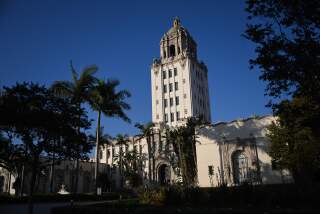Op-Ed: L.A. badly needs housing, and Palladium Residences more than fits the need
- Share via
There’s a revolution happening in Los Angeles: Rapid transit stretches from Hollywood to Santa Monica, from Pasadena to Long Beach, and people are moving back into the urban core rather than farther out, defying the cliche that we are 72 suburbs in search of a city. Search no longer: Los Angeles is becoming a model metropolis for the 21st century, with one very major obstacle: We are facing the greatest housing crisis in America.
Shocking as it may sound, it is easier to find an apartment in New York than here. (We have fewer vacancies.) Our supply of new units is fewer per capita than San Francisco’s. Apartment rents continue to skyrocket at double the rate of inflation and are now hovering around $1,873 per month, on average. The San Fernando Valley and the Inland Empire used to provide some relief, but not anymore. And the gap between income and the cost of housing is greater in Los Angeles than any place in the nation. Even as minimum-wage battles yield some increases, the housing shortage remains critical, causing Mayor Eric Garcetti to call for 100,000 new units by 2021.
Density is inevitable; the only questions are how we build it and where we want it.
Given the severity of L.A.’s housing crisis, what’s all the brouhaha about the Palladium Residences project in Hollywood? It promises more than 700 apartments two blocks from the Hollywood/Vine Metro stop, which is exactly the sort of development we need in post-suburban Los Angeles. Nevertheless, it has met with months of litigation and protest, and the battle continues. Indeed, opponents vowed last week to “exhaust every possible avenue to stop this project.”
Does the Palladium developer, Crescent Heights, want to bulldoze some architectural gem or vital part of the neighborhood? Is the project incompatible with the surroundings, either in use or scale? Is it an eyesore? The answer: none of the above.
Los Angeles real estate interests have a long history of trouncing communities that get in the way of development, especially poor communities of color — think Chavez Ravine, or the neighborhoods buried under freeway construction. But the Palladium won’t displace a single person.
Rather than detract from the neighborhood, the project adds pedestrian activity and amenities. Its site design calls for shops and restaurants at the ground level, a public open space on each of three bordering streets, public rooftop terraces and plenty of parking. The project does this while framing and preserving the Hollywood Palladium — not a particularly remarkable work of architecture but a treasure trove of entertainment history since its opening in 1940.
It’s true that the Palladium’s two new residential towers, at 28 stories, are tall by L.A. standards. But existing buildings that flank the project are only slightly shorter, so the claim that the new project doesn’t fit the context is a stretch.
Leading the Palladium opposition is Kilroy Realty Corp., which owns the towers on both sides of the Palladium, and its tenant, the AIDS Healthcare Foundation. So tall buildings are OK, but only if they’re already occupied? That’s a classic case of pulling up the ladder.
As for aesthetics, only critics opposed to height no matter what — who never see beauty in verticality — would call the Palladium towers an eyesore. They are designed by a talented California architect, Stanley Saitowitz, who has built stunning residential projects in San Francisco.
Lacking better ammunition, detractors mainly use the D-word. I’m talking about “density,” the term hurled at every project Angelenos want to defeat. Density in the case of the Palladium project is code for traffic, and fair enough, the towers will add cars in the immediate vicinity. In the grander scheme of things, though, density improves mobility because everyday life — work, home, play — is more compact. By contrast, if we insist on sprawl, everyone has to drive long distances.
No new development is ever perfect, but the critics have the Palladium’s problems all wrong.
They say there are too many housing units, instead of too few affordable ones. Crescent Heights has suggested that its smaller units without luxury amenities will fall into the mid-market range. It hasn’t finalized its plans, though, so there’s time to negotiate a generous number of apartments — 25% of the total, say — priced within reach of lower income Angelenos.
Critics are also ignoring the one part of the project that really will be bad for traffic: the nearly 2,000 proposed parking spaces spread across the site. Plentiful parking doesn’t solve congestion; it encourages it by laying out a welcome mat for everyone who wants to drive.
We’ve already proved — even here in Los Angeles — that people are willing to ride rather than drive, and to house themselves without housing a car. In downtown L.A., for instance, plenty of people are buying and renting apartments without dedicated parking spots, forgoing cars on short trips and increasing that most desirable type of congestion — pedestrians on sidewalks.
Angelenos may still think of their city as a suburban metropolis, but as the population grows, low-rise development becomes increasingly untenable. Density is inevitable; the only questions are how we build it and where we want it. If we can’t add well-designed housing in Hollywood, just two blocks from the Red Line, where should it go? Anyone who answers “nowhere” or “your neighborhood, not mine” doesn’t have any solution at all.
Dana Cuff is professor of architecture and urban design at UCLA and director of cityLAB-UCLA.
Follow the Opinion section on Twitter @latimesopinion and Facebook
More to Read
A cure for the common opinion
Get thought-provoking perspectives with our weekly newsletter.
You may occasionally receive promotional content from the Los Angeles Times.










